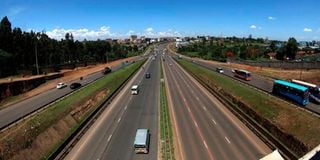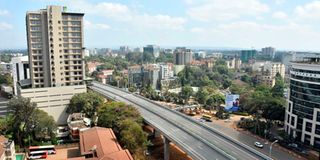
The Nairobi Expressway overpasses the Prof Wangari Maathai Road-Waiyaki Way junction at the Museum Hill interchange in Westlands.
| File | Nation Media GroupKenya@60
Premium
Roads to prosperity: Mwai Kibaki’s legacy continues to bear fruit
For close to a decade, Thika Superhighway stood out as an infrastructural masterpiece representing Kenya’s journey from independence to a country shuttling towards a middle-income status.
Described by former President Mwai Kibaki as a source of national pride during its launch in November 2012, three years after its groundbreaking, the 50km-long road was a first-of-its-kind modern highway in the country.
Starting from Nairobi City, running through different towns before spilling to the outskirts of Thika, the $360 million (Sh36 billion at the time) colossal eight-lane highway represented the growth of Kenya's road network.
But what was Mr Kibaki’s infrastructural legacy would soon be dwarfed by a mega project by his successor, Uhuru Kenyatta. The iconic Nairobi Expressway. The 27.1 kilometres expressway, one of Uhuru’s signature projects, marked another milestone in Kenya’s infrastructural evolution, easily beating the Thika Superhighway to the punch.
The two projects are an indication of the journey travelled by Kenya as it continues to undergo a physical infrastructural facelift 60 years since independence.
Major towns and cities have seen growth in their road network as multi-billion road projects continue to take shape.
From the 17.7 kilometres Dongo Kundu bypass highway in Mombasa to the 135 kilometre Nuno-Modogashe road project in the North, Kenya’s road network has experienced significant growth. Roads and Transport Cabinet Secretary, Kipchumba Murkomen, said that since independence, a total of 21,556 kilometres of tarmac road have been laid down, with a national average of 458 kilometres for each of the 47 counties.
However, the huge upturn in growth of road coverage in the country is down to Uhuru’s appetite for huge infrastructural projects, in particular, investment in expansion of Kenya’s road network.
Between 2013 and 2022, the Jubilee government pumped in Sh1.44 trillion on construction and maintenance of roads, constructing a total of 11,000 kilometres of new highways. This was close to six times what his predecessor managed to build in the 10 years he was in power between 2002 and 2012.

A section of the Thika superhighway.
When he was leaving, Uhuru's administration left 2,000 kilometres of inter-city highways under construction and 500 kilometres of urban roads under different stages of construction or procurement.
In the first term, Uhuru spent Sh490 billion on roads, while in the second term, the expenditure nearly doubled, jumping to Sh951 billion, in the process building more roads than the three previous administrations before him combined.
Put into perspective, in the 39 years since independence and even before, Kenya only had 8,556 kilometres of road network. The late Kibaki’s administration, however, is credited with putting up 2,000 kilometres of tarmac road, the Thika Superhighway being the highlight of them all. The third president spent Sh474.9 billion on roads with Sh117.6 billion, during his last year in office, being the highest spending on roads.

A tuktuk on the Dongo Kundu bypass in Mombasa County on December 17, 2022.
Another landmark in the country’s road coverage journey is the ongoing Lamu Port South Sudan Ethiopia Transport (Lapsset) corridor which will link Kenya with Ethiopia, Uganda and South Sudan. Eastern Africa’s largest and most ambitious infrastructure project, it consists of seven key programmes comprising a road component made up of interregional highways from Lamu to Isiolo, Isiolo to Juba (South Sudan), Isiolo to Addis Ababa (Ethiopia), and Lamu to Garsen (Kenya).
There is also the 175km Rironi-Mau Summit Highway, touted to overshadow the Nairobi Expressway, directly serving an estimated population of six million and another 19 million people living in Nakuru county and beyond.
The Rironi-Nakuru-Mau Summit Highway, forming part of the Northern corridor, transverses Kiambu and Nakuru counties and had been planned for upgrade at a cost of Sh160 billion.
Signaling the extent of heavy investments in roads by the previous regime, President William Ruto said in a recent interview that he found a commitment of Sh900 billion in infrastructure projects by the previous administration.
His government has, however, scaled this down by nearly a quarter, or Sh220 billion, and in the process abandoned the construction of 1,089km of roads as well as shelved the rehabilitation and maintenance of 2,304km in the current financial year. The Jubilee government is credited with dualling of the 16km Western Bypass which will shorten the distance from Kiambu to Kajiado, as it connects to the Southern Bypass. The road passes through several towns, which include Gitaru, Wangige, Ndenderu and Ruaka, and is the fourth and final ring road in the Nairobi Ring Road Network Masterplan.
There is also the expansion of the 28km Eastern Bypass into a dual carriageway. The bypass starts at City Cabanas along Mombasa Road, linking motorists through Ruai towards Ruiru, passing over Thika Road to Ruaka where it joins the Northern bypass. The 31-kilometre Northern bypass starts from Ruaka trading centre along Limuru Road and overpasses Banana Road through Runda and Thome estates. It then proceeds to Kahawa West and eventually to Ruiru through Kamae, where it joins the Eastern Bypass. Completing the mega road projects in the metropolitan area is the Nairobi Southern Bypass, which was completed in 2016.

An aerial view of the Nairobi Expressway.
The 28.6-km bypass dual carriageway begins on the southern edges along Nairobi-Mombasa Road, passes through Gitaru in the northern part of the town and connects to the Western Bypass.
Western Bypass
The heavy investments in infrastructure projects by the two previous regimes have spurred economic growth in the areas. In a speech to mark 59 years of independence, Kenyatta said: “Infrastructure has a way of turning swamps into cities, dead spaces into high-value property, and village shopping centres into huge city malls. Without infrastructure, there is no way of finding new possibilities.”
Vibrant economic activities have been come up along road projects, leading to creation of employment opportunities as well as boosting the economy. Residential homes and estates have also come up, as well as commercial buildings such as malls: TRM, Garden City, Juja City, Vintage Mall and University Mall at Kenyatta University. Entertainment joints and recreational centres have also been established along the Thika Superhighway as investors rush to cash in on the increased activity along the stretch. The trickle-down has also been felt with older economic centres and estates close to the highway such as Roysambu, Garden Estate, Ruaraka, Kasarani, Ruiru, Juja, Kahawa Sukari and Kahawa Wendani, registering considerable growth.
There are multi-story apartments charging as much as Sh18,000 for a one-bedroom unit as rent skyrockets, while the price of land has also gone up with 60 by 40 feet to 100 by 100 feet now fetching more millions depending on location from the highway.
“Apartments are being built every day, rarely will you find a vacant house,” says Peter Ochieng, a resident of Kasarani.
Expected to not only help Kenya realise its objective of attaining the status of a middle-income country by 2030, Thika Superhighway was also expected to boost the economy of the East Africa region with the project covering a vital route – the Great North-Trans African Highway, which links Cape Town and Cairo. In addition, the highway connects Kenya with Ethiopia and Tanzania in the North and South, respectively. With the Central region being a mainly agricultural area, the efficient transport system has been of great value to farmers. The superhighway connects Nairobi to the untapped North of the country covering Marsabit, Isiolo, Moyale and Mandera, all primary commercial centres of Kenya. The net effect has been reduced traffic congestion, saving the economy billions lost in traffic gridlock.
Traffic congestion
Several reports have shown that traffic congestion in Nairobi alone costs Kenya close to Sh1.50 billion every month, with Nairobi being the second most congested city in Africa and the fourth in the world.
The four-lane Sh89 billion Nairobi Expressway – the first-of-its-kind in Africa – has also had even a bigger economic benefit. The road, a class A four-lane dual carriage, connects the Jomo Kenyatta International Airport from the Mlolongo area in Nairobi and stretches through to the Central Business District and terminates at James Gichuru Road in the Westlands area of the same city. The double-decker highway has cut a rush-hour trip to the airport from over two hours to 25 minutes – for those who can afford it. Motorists pay between Sh120 and Sh1,800 at the point of exit, depending on the vehicle size and the distance covered.
Kenya Railways Corporation managing director, Philip Mainga, in an opinion piece published by the Business Daily, said infrastructure is important in fostering countries' economic development and prosperity.
The highlight, he said, is the Nairobi Expressway, which is part of the northern corridor that provides passage to 85 percent of the cargo destined for neighbouring landlocked countries such as Uganda, Rwanda, the Democratic Republic of Congo and South Sudan. The government has also set five years to improve and increase the road network in 14 marginalised counties to the level of other areas in the country in order to bring the much-needed development in the counties.
The counties include Turkana, Lamu, Mandera, Wajir, Marsabit, Samburu, West Pokot, Tana River, Narok, Kwale, Garissa, Kilifi, Taita Taveta and Isiolo.





